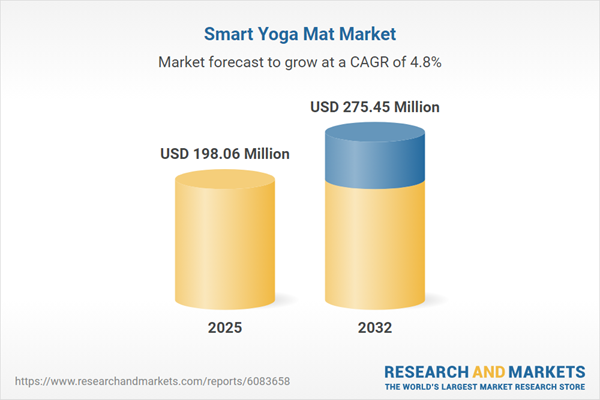Speak directly to the analyst to clarify any post sales queries you may have.
The smart yoga mat market is undergoing a pivotal transformation, fuelled by continuous innovation, shifting consumer demands, and growing expectations for connected fitness experiences. This evolving sector is capturing the attention of enterprises and solution providers looking to drive differentiated value in personal wellness technology.
Market Snapshot: Smart Yoga Mat Market Size and Growth
The global smart yoga mat market grew from USD 188.72 million in 2024 to USD 198.06 million in 2025. With an anticipated CAGR of 4.84%, projections indicate the sector will reach USD 275.45 million by 2032. Consistent expansion is being powered by connected fitness trends, digital integration, and heightened consumer expectations for data-driven, interactive wellness solutions. These drivers are fostering sustained demand across both institutional and at-home fitness landscapes.
Scope & Segmentation of the Smart Yoga Mat Market
- End Users: Commercial (gyms, studios), Individual (home, traveler)
- Distribution Channels: Online retail (brand website, e-commerce platform), Specialty store (sports store, yoga studio retail)
- Material Types: Natural rubber, PVC, TPE
- Connectivity Options: Bluetooth (BLE, Classic), NFC, Wi-Fi (2.4 GHz, 5 GHz)
- Price Ranges: High, medium, low
- Geographic Coverage: Americas (United States, Canada, Mexico, Brazil, Argentina, Chile, Colombia, Peru); Europe, Middle East & Africa (United Kingdom, Germany, France, Russia, Italy, Spain, Netherlands, Sweden, Poland, Switzerland, United Arab Emirates, Saudi Arabia, Qatar, Turkey, Israel, South Africa, Nigeria, Egypt, Kenya); Asia-Pacific (China, India, Japan, Australia, South Korea, Indonesia, Thailand, Malaysia, Singapore, Taiwan)
- Key Companies: YogiFi Pvt. Ltd., SmartMat Technologies Limited, SOMATIQ GmbH, SKLZ Inc., ZenMat Labs LLC
Key Takeaways for Senior Decision Makers
- Smart yoga mats are integrating advanced sensors and artificial intelligence, providing users with personalized feedback for improved practice precision and risk management.
- Business clients, such as fitness studios and gyms, increasingly prioritize scalable solutions that offer aggregated analytics and engagement tools for member retention.
- Growth in at-home fitness models and hybrid wellness routines is driving innovation in portable, app-connected mat designs suited to remote instruction.
- Material sustainability is now central, with eco-conscious consumer segments and regulations demanding biodegradable, non-toxic, and recyclable components.
- Collaboration between hardware manufacturers, software developers, and content creators is shaping differentiated user experiences and supporting new revenue models linked to digital services.
- Segmented pricing strategies enable stakeholders to address a diverse customer base, from cost-sensitive individuals to high-value commercial clients seeking premium features.
Tariff Impact: Navigating Trade and Policy Shifts
Recent US foreign trade policy adjustments and tariff increases have created new operational challenges, particularly for firms reliant on imported sensors and polymer components. Manufacturers and importers are actively reassessing sourcing, with a move toward nearshoring and regional partnerships to maintain margin stability while ensuring product quality. Flexible supply chain models and vertical integration are being evaluated to safeguard against future disruptions. Companies adapting quickly to regulatory changes are better positioned to protect profitability and support long-term growth.
Research Methodology & Data Sources
This report employs a multi-stage research framework, combining comprehensive secondary data with targeted primary interviews. Sources include company reports, industry documentation, executive interviews, and structured surveys, providing insight into operational priorities and evolving user preferences. Data triangulation and analytical frameworks validate conclusions and ensure actionable guidance for stakeholders.
Why This Smart Yoga Mat Market Report Matters
- Empowers leaders to align product strategies with the latest innovations in sensor integration, digital content, and sustainability demand across the value chain.
- Informs decisions on channel development and geographic expansion by mapping consumer preferences and competitive dynamics in established and emerging regions.
- Supports proactive response to trade regulations, enabling risk mitigation in supply chains and stronger business continuity planning.
Conclusion
The smart yoga mat market is reshaping the intersection of wellness and technology, opening pathways for targeted innovation and strategic alliances. Stakeholders who track evolving consumer patterns and adapt to regulatory and technological shifts are primed for sustained market leadership and value creation.
Table of Contents
3. Executive Summary
4. Market Overview
7. Cumulative Impact of Artificial Intelligence 2025
Companies Mentioned
The companies profiled in this Smart Yoga Mat market report include:- YogiFi Pvt. Ltd.
- SmartMat Technologies Limited
- SOMATIQ GmbH
- SKLZ Inc.
- ZenMat Labs LLC
Table Information
| Report Attribute | Details |
|---|---|
| No. of Pages | 194 |
| Published | October 2025 |
| Forecast Period | 2025 - 2032 |
| Estimated Market Value ( USD | $ 198.06 Million |
| Forecasted Market Value ( USD | $ 275.45 Million |
| Compound Annual Growth Rate | 4.8% |
| Regions Covered | Global |
| No. of Companies Mentioned | 6 |









